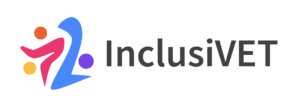Chapter 1 – Tool Description
1. What is the goal of the self-assessment system
Through this self-assessment, VET schools can gain a deeper understanding of the extent to which they implement inclusive strategies and practices connected to learner engagement, and how these strategies align with their overall institutional goals. Additionally, it enables VET schools to continuously monitor their progress and evaluate the presence of policies and practices that cater to learners with specific characteristics. These learners may be either overrepresented or underrepresented in key stages of the education process. The primary objective of the self-assessment is to leverage data-driven insights to guide a school’s aspirations and stimulate significant improvements.
The self-assessment tool is designed to be used by individual VET schools and contains five categories related to inclusive learner engagement, with each being subdivided into several statements. Different sets of questions are tailored for specific groups, including institutional leaders, student services, support staff, and students. The self-assessment yields both individual reports and a consolidated institutional report for the respective VET school. When responding to the questions, it should be kept in mind that there are no right or wrong answers. It is the evaluation of the school, based on its unique characteristics and context. There won’t be any comparisons with other schools or countries. Additionally, it’s worth noting that the tool allows for anonymous submissions and adheres to GDPR regulations.
2. Structure of self-assessment: important areas for the manifestation of inclusiveness
The tool looks at a number of thematic areas of the inclusivity in the VET school based on the whole school approach. These are areas where you can measure, influence, and develop institutional inclusiveness in your VET school. You should be aware that these areas can be measured and developed independently but are interconnected. This means that the strengths or weaknesses of one area will have an impact on the strengths and weaknesses of the other areas, and if we neglect an important aspect in one area, the impact on the other areas will be negative for inclusivity and integration.
The following areas are interconnected
- Area A: Sense of Belonging[1] – Learner participation and sense of belonging are closely connected. Firstly, it alludes to feeling part of or the perception of emotional well-being resulting from a settled social and academic self-esteem. It also symbolises being part of a peer group, where learners are valued and recognised and where identities are constructed in positive and not deficient or of lesser value over any learner. And, finally, it involves taking part in the formal and informal bodies and structures of educational participation.
- Area B: Teaching and Learning[2] – The environment of teaching, learning and assessment is where learners and staff will most often engage. Approaches to learner engagement should seek to find balance between learner engagement in their own learning and learner engagement in the process of enhancing that learning. Partnership in this space can be pedagogical, curricular, and extra-curricular, founded on collaborative relationships, where staff and learners recognise that their engagement can have wider influence in institutional change, emerging good practice, and quality improvement.
- Area C: Governance and Management – Learner engagement in governance and management of VET schools can be enhanced through their involvement in committees, boards, etc. However, a broader understanding is needed about different obstacles that can limit this participation to be meaningful and effective. Recognition of non-formal forms of participation, pre-existing hierarchies, decision-making cultures, and knowledge or information asymmetry is crucial. It is from the governance domain that learner engagement can be embedded throughout all institutional decision-making, projects, and policy developments. This area cover and evaluate the following features of the inclusive management:
- C1. Institutional Culture
- C2. Functioning of the governance structure
- C3. Learner representation in governance & management
- Area D: Learner Support – Learner support is a distinctive element of education and a prerequisite for building more inclusive VET schools. The possibility of access to teaching and learning for all people including underrepresented learners and the preparation of environments to make their participation possible is necessary.
- Area E: Quality Assurance and Enhancement – Learner engagement, quality assurance, and enhancement should involve active learner participation at all stages. This means that the process itself should effectively capture and understand how learner engagement and participation are supported in practice. When you include systematic learner participation in quality assurance, you can better respond to the needs and goals of all learners. This also helps provide the support that you need to make partnerships a reality.
To summarise, in this chapter you have learned about the purpose of the self-assessment, its structure and the relationship between its different areas. Finally, you have learned about the specific meaning of each area. You are now ready to enter the self-assessment system and to try it out.
[1] We dedicate a whole module to the learners’ sense of belonging. You can find it in Module 4. We highly suggest that you read this unit as well.
[2] Another whole module dealing with the Teaching and Learning aspect of the inclusive education in VET. Please find it as Module 5.
